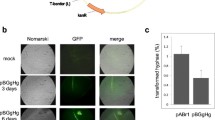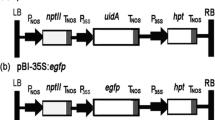Abstract
TheAgrobacterium tumefaciens-mediated transformation of the zygomycetous fungusMucor circinelloides is described. A method was also developed for the hygromycin B-based selection ofMucor transformants. Transformation with the hygromycin B phosphotransferase gene ofEscherichia coli controlled by the heterologousAspergillus nidulans trpC promoter resulted in hygromycin B-resistant clones. The presence of the hygromycin resistance gene in the genome of the transformants was verified by polymerase chain reaction and Southern hybridization: the latter analyses revealed integrations in the host genome at different sites in different transformants. The stability of transformants remained questionable during the latter analyses.
Similar content being viewed by others
References
Amey R.C., Athey-Pollard A., Burns C., Mills P.R., Bailey A., Foster G.D.: PEG-mediated andAgrobacterium-mediated transformation in the mycopathogenVerticillium fungicola.Mycol.Res. 106, 4–11 (2002).
Anaya N., Roncero M.I.G.: Transformation of a methionine auxotrophic mutant ofMucor circinelloides by direct cloning of the corresponding wild-type gene.Mol.Gen.Genet. 230, 449–455 (1991).
Arnau J., Stroman P.: Gene replacement and ectopic integration in the zygomyceteMucor circinelloides.Mol.Gen.Genet. 23, 542–546 (1993).
Arnau J., Jepsen L.P., Stroman P.: Integrative transformation by homologous recombination in the zygomyceteMucor circinelloides.Mol.Gen.Genet. 225, 193–198 (1991).
Benito E.P., Díaz-Minguez J.M., Iturriaga E.A., Campuzano V., Eslava A.P.: Cloning and sequence analysis of theMucor circinelloides pyrG gene encoding orotidine-5′-monophosphate decarboxylase: use ofpyrG for homologous transformation.Gene 225, 59–67 (1992).
Benito E.P., Campuzano V., López-Matas M.A., de Vicente J.I., Eslava A.P.: Isolation, characterization and transformation by autonomous replication ofMucor circinelloides OMPdecase-deficient mutants.Mol.Gen.Genet. 248, 126–135 (1995).
Bundock P., Hooykaas P.J.J.: Integration ofAgrobacterium tumefaciens T-DNA in theSaccharomyces cerevisiae genome by illegitimate recombination.Proc.Nat.Acad.Sci.USA 93, 15272–15275 (1996).
Bundock P., Dendulkras A., Beijersbergen A., Hooykaas P.J.J.: Transkingdom T-DNA transfer fromAgrobacterium tumefaciens toSaccharomyces cerevisiae.EMBO J. 14, 3206–3214 (1995).
Campoy S., Perez F., Martin J.F., Gutierrez S., Liras P.: Stable transformants of the azophilone pigment-producingMonascus purpureus obtained by protoplast transformation andAgrobacterium-mediated DNA transfer.Curr.Genet. 43, 447–452 (2003).
Covert S.F., Kapoor P., Lee M., Briley A., Nairn C.J.:Agrobacterium tumefaciens-mediated transformation ofFusarium circinatum.Mycol.Res. 105, 259–264 (2001).
Dickinson L., Harboe M., van Heeswijk R., Stroman P., Jepsen L.P.: Expression of activeMucor miehei aspartic protease inMucor circinelloides.Carlsberg Res.Commun. 52, 243–252 (1987).
Godtfredsen S.E.: Microbial lipases, pp. 255–274 in W.M. Fogarty, C.T. Kelly (Eds):Microbial Enzymes and Biotechnology, 2nd ed. Elsevier, London 1990.
Gooday G.W.: Hormones in mycelial fungi, pp. 401–411 in J.G.H. Wessels, F. Meinhardt (Eds):The Mycota, Vol. 1. Springer-Verlag, Berlin 1994.
de Groot M.J.A., Bundock P., Hooykaas P.J.J., Beijersbergen A.G.M.:Agrobacterium tumefaciens-mediated transformation of filamentous fungi.Nature Biotechnol. 16, 839–842 (1998).
van Heeswijck R., Roncero M.I.G.: High frequency transformation ofMucor with recombinant plasmid DNA.Carlsberg Res.Commun. 49, 691–702 (1984).
Hocking A.D.: Improved media for enumeration of fungi in foods.CSIRO Food Res.Quart. 41, 7–11 (1981).
Hood E.E., Helmer G.L., Fraley R.T., Chilton M.D.: The hypervirulence ofAgrobacterium tumefaciens A281 is encoded in the region pTiBo542 outside the T-DNA.J.Bacteriol. 168, 1291–1301 (1986).
Iturriaga E.A., Díaz-Minguez J.M., Benito E.P., Alvarez M.I., Eslava A.P.: Heterologous transformation ofMucor circinelloides with thePhycomyces blakesleeanus leuI gene.Curr.Genet. 21, 215–223 (1992).
Iturriaga E.A., Velayos A., Eslava A.P.: Structure and function of the genes involved in the biosynthesis of carotenoids in theMucorales.Biotechnol.Bioproc.Eng. 5, 263–274 (2000).
Iturriaga E.A., Velayos A., Eslava A.P., Alvarez M.I.: The genetics and molecular biology of carotenoid biosynthesis inMucor.Rec.Res.Dev.Genet. 1, 79–92 (2001).
Jung M.K., Ovechkina Y., Prigozhina N., Oakley C.E., Oakley B.R.: The use of β-d-glucanase as a substitute for Novozym 234 in immunofluorescence and protoplasting.Fungal Genet.Newslett. 47, 65–66 (2000).
Kado C.I.: Molecular mechanisms of crown gall tumorigenesis.Crit.Rev.Plant Sci. 10, 1–32 (1991).
King A.D. Jr.,Hocking A.D., Pitt J.I.: Dichloran-Rose Bengal medium for enumeration and isolation of molds from foods.Appl.Environ.Microbiol. 37, 959–964 (1979).
Lazo G.R., Stein P.A., Ludwig R.A.: A DNA transformation-competentArabidopsis genomic library inAgrobacterium.Biotechnology 9, 963–967 (1991).
Leach J., Finkelstein D.B., Rambosek J.A.: Rapid miniprep of DNA from filamentous fungi.Fungal Genet.Newslett. 33, 32–33 (1991).
Malonek S., Meinhardt F.:Agrobacterium tumefaciens-mediated genetic transformation of the phytopathogenic ascomyceteCalonectria morganii.Curr.Genet. 40, 152–155 (2001).
Michielse C.B., Salim K., Ragas P., Ram A.F.J., Kudla B., Jarry B., Punt P.J., van den Hondel C.A.M.J.J.: Development of a system for integrative and stable transformation of the zygomyceteRhizopus oryzae byAgrobacterium-mediated DNA transfer.Mol.Genet.Genomics 271, 499–510 (2004).
Mikosh T.S.P., Lavrijssen B., Sonnenberg A.S.M., van Griensven L.J.L.D.: Transformation of the cultivated mushroomAgaricus bisporus (Lange) using T-DNA fromAgrobacterium tumefaciens.Curr.Genet. 39, 35–39 (2001).
Monfort A., Cordero L., Maicas S., Polaina J.: Transformation ofMucor miehei results in plasmid deletion and phenotypic instability.FEMS Microbiol.Lett. 224, 101–106 (2003).
Mullins E.D., Chen X., Romaine P., Raina R., Geiser D.M., Kang S.:Agrobacterium-mediated transformation ofFusarium oxysporum: an efficient tool for insertional mutagenesis and gene transfer.Phytopathology 91, 173–180 (2001).
Obraztsova I.N., Prados N., Holzmann K., Avalos J., Cerdá-Olmedo E.: Genetic damage following introduction of DNA inPhycomyces.Fungal Genet.Biol. 41, 168–180 (2003).
Orlowsky M.:Mucor dimorphism.Microbiol.Rev. 55, 234–258 (1991).
Outtrup H., Boyce C.O.L.: Microbial proteinases and biotechnology, pp. 227–254 in W.M. Fogarty, C.T. Kelly (Eds):Microbial Enzymes and Biotechnology, 2nd ed. Elsevier, London 1990.
Roncero M.I.G., Jepsen L.P., Stroman P., van Heeswijck R.: Characterization of aleuA gene and anARS element fromMucor circinelloides.Gene 84, 335–343 (1989).
Ruiz-Herrera J.: Dimorphism inMucor species, pp. 257–265 in H. van den Bossche, F.C. Odds, D. Herridge (Eds):Dimorphic Fungi in Biology and Medicine. Plenum Press, New York 1993.
Ruiz-Hidalgo M.J., Eslava A.P., Alvarez M.I., Benito E.P.: Heterologous expression of thePhycomyces blakesleanus phytoene dehydrogenase gene (carB) inMucor circinelloides.Curr.Microbiol. 39, 259–264 (1999).
Sambrook J., Fritsch E.F., Maniatis T.:Molecular Cloning: a Laboratory Manual. Cold Spring Harbor Laboratory Press, Cold Spring Harbor 1989.
Skaar I., Stenwig H.: Malt-yeast extract-sucrose agar, a suitable medium for enumeration and isolation of fungi from silage.Appl.Environ.Microbiol. 62, 3614–3619 (1996).
Velayos A., Alvarez M.I., Eslava A.P., Iturriaga E.A.: Interallelic complementation at thepyrF locus and the homodimeric nature of orotate phosphoribosyltransferase (OPRTase) inMucor circinelloides.Mol.Gen.Genet. 260, 251–260 (1998).
Wolf A.M., Arnau J.: Cloning of glyceraldehyde-3-phosphate dehydrogenase-encoding genes inMucor circinelloides (syn.racemosus) and use of thegpáI promoter in recombinant protein production.Fungal Genet.Biol. 35, 21–29 (2002).
Author information
Authors and Affiliations
Additional information
This research was supported in part by theHungarian Scientific Research Fund (OTKA) grants T037471, F046658 and D048537.
Rights and permissions
About this article
Cite this article
Nyilasi, I., Ács, K., Papp, T. et al. Agrobacterium tumefaciens-mediated transformation ofMucor circinelloides . Folia Microbiol 50, 415–420 (2005). https://doi.org/10.1007/BF02931423
Received:
Revised:
Issue Date:
DOI: https://doi.org/10.1007/BF02931423




